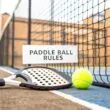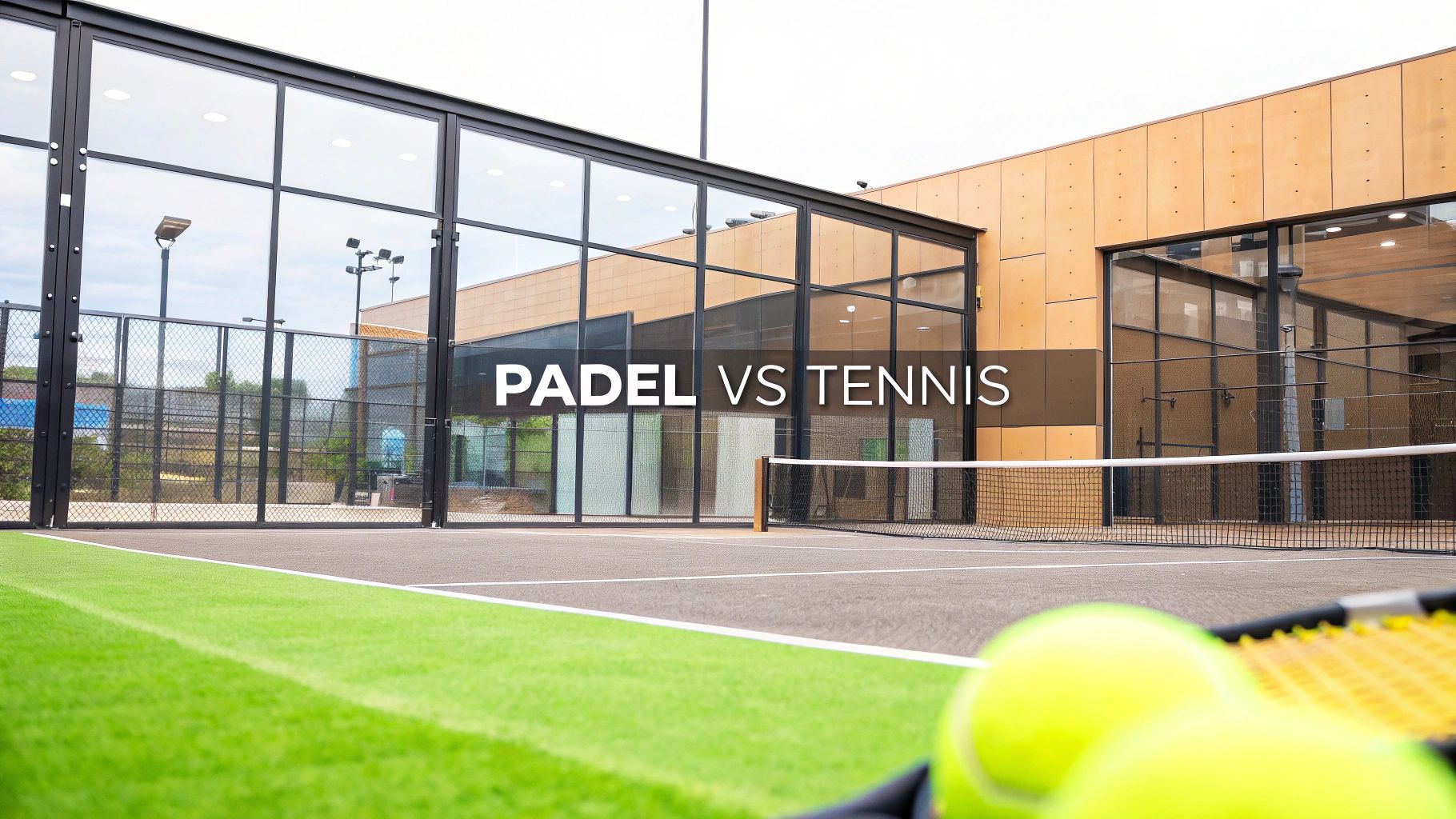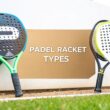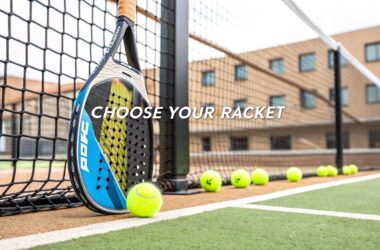When you boil it down, the whole padel vs tennis debate really comes down to two things: accessibility and intensity.
Padel is all about social, strategic fun with a really gentle learning curve. This makes it fantastic for beginners and anyone looking for a more collaborative game. Tennis, on the other hand, is that classic athletic challenge. It demands more physical fitness and technical skill, which is perfect if you love pushing yourself in a one-on-one competition.
Understanding the Core Differences
Choosing between padel and tennis really depends on what you're looking for. Think about your fitness goals, how much you want to socialize, and what kind of challenge you're up for. While they're both awesome racket sports, they take you on completely different journeys.
You'll often hear padel described as a mash-up of tennis and squash. You play on an enclosed court where the walls are part of the game. This simple twist creates longer, more interesting rallies that are more about smart tactics than just raw power.

Buy the best padel gear to level up your next game!
CHECK OUT this deal from Padel Market!Get ready to take your game to the next level with the latest padel gear from Padel Market! Fast EU and Worldwide Shipping
Tennis is the more traditional—and physically punishing—of the two. The court is bigger and open, so you need serious stamina to cover the ground. Mastering the powerful serves and explosive groundstrokes takes a lot of practice, making the learning curve much steeper.
Quick Comparison Key Differences Between Padel and Tennis
To give you a quick snapshot of how these sports really differ, here’s a simple side-by-side look at their key features. This will help you get a feel for them before we dive deeper.
| Feature | Padel | Tennis |
|---|---|---|
| Court Size | Smaller (20m x 10m), enclosed with walls | Larger (23.77m x 10.97m for doubles), open |
| Racket Type | Solid, stringless paddle (pala) with holes | Larger, strung racket |
| Ball Pressure | Lower pressure, resulting in a slower bounce | Higher pressure for a faster, higher bounce |
| Learning Curve | Gentle and beginner-friendly | Steep, requires more technical skill |
| Gameplay Focus | Strategy, teamwork, and precision | Power, athleticism, and endurance |
| Social Aspect | Highly social, almost always played in doubles | Can be individual (singles) or team-based (doubles) |
This table gives you the stats, but sometimes a picture just makes it click.
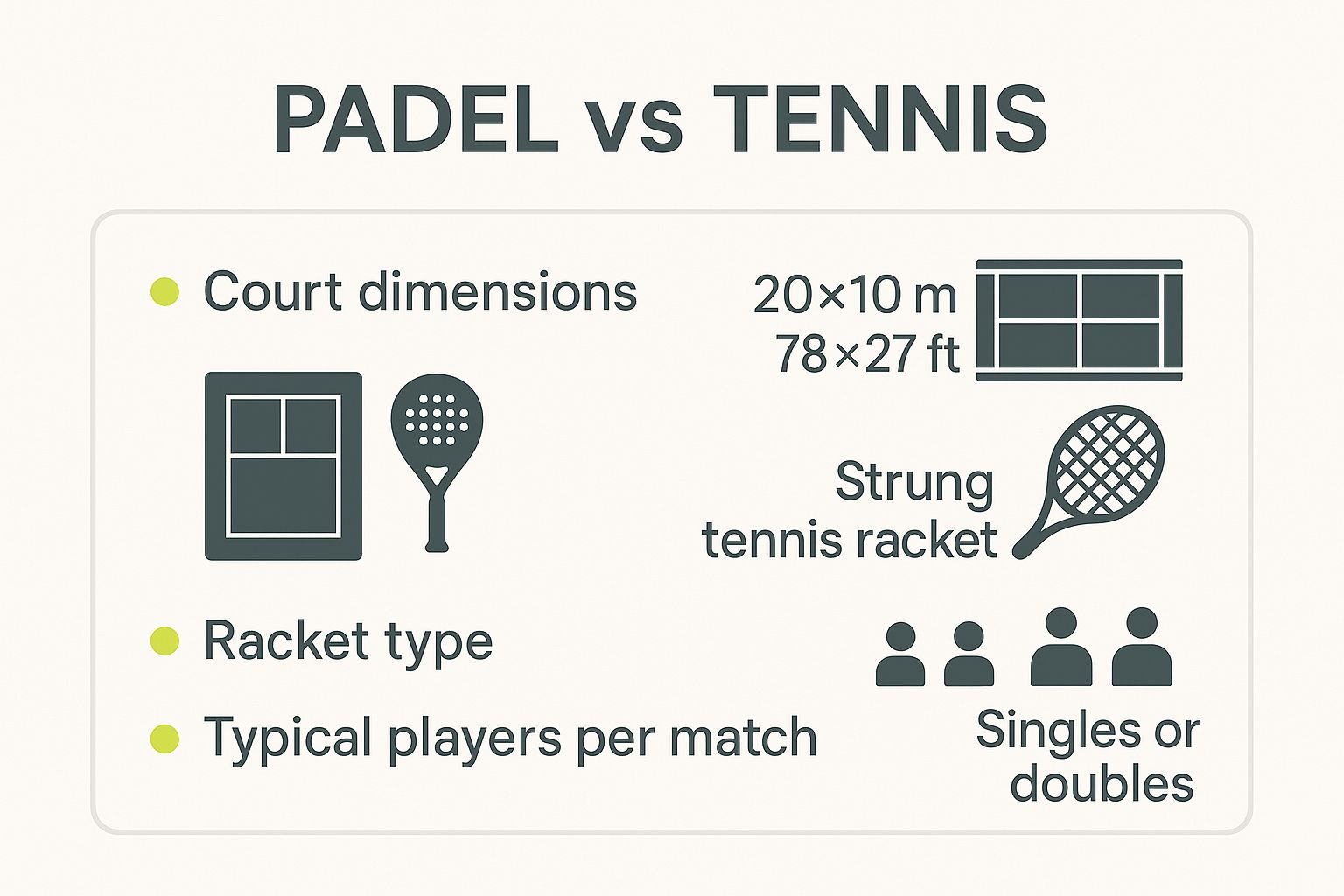
As you can see, padel's contained court and doubles-only format create a much more intimate, team-oriented game. It’s a sharp contrast to the wide-open, power-focused world of tennis. These core differences are exactly what will help you decide which sport is the right fit for you.
Comparing the Court and Equipment
At first glance, the most obvious differences between padel and tennis are the court and the gear. But these aren't just minor details—they completely shape the strategy, physical demands, and the entire vibe of each sport. The unique arenas and tools are what dictate the pace of the game and the kinds of shots you can even attempt.
A padel court is noticeably smaller and more enclosed, measuring 20 meters long by 10 meters wide. Its defining feature, though, is the enclosure—a mix of glass walls and metal mesh fencing. These walls aren't just boundaries; they're an active part of the game. Players use them to rebound the ball in ways that would be unthinkable in tennis, turning rallies into a dynamic puzzle of angles and tactics.
The compact court size naturally pushes players closer together, making constant communication and teamwork essential in the mandatory doubles format. It's less about sprinting across vast distances and more about lightning-fast reactions and smart ball placement.
The Arena: Tennis Open Space vs. Padel Enclosure
In sharp contrast, a standard tennis court feels like a huge open expanse. At 23.77 meters long by 10.97 meters wide for doubles, it requires serious athleticism and stamina. There are no walls to bail you out of a wide shot, putting a huge emphasis on power, precision, and endurance.
The open layout of a tennis court creates a game dominated by long-range groundstrokes, powerful serves, and aggressive net play. Players have to generate all their own pace and angles without any help from rebounding surfaces. This fundamental design difference is at the core of the padel vs tennis debate.
The walls in padel add a layer of strategic depth that just doesn't exist in tennis. A shot that would be a clean winner on a tennis court can be played off the back glass in padel, completely flipping the dynamic of a point.
This key distinction makes padel feel more like a strategic chess match in a box, while tennis often rewards raw power and athletic dominance. Your choice between them might come down to whether you prefer a tactical game of patience or a high-intensity athletic duel on an open field. For a deeper dive into these gameplay nuances, check out our comprehensive guide on padel versus tennis.
Rackets and Balls: The Tools of the Game
The equipment used in each sport highlights their differences even more. A tennis racket is what most people picture: a large, strung head built to generate incredible power and spin. Its design is perfect for the larger court, letting players unleash blistering serves and deep, powerful groundstrokes from the baseline.
A padel racket, or "pala," couldn't be more different. It’s a solid, stringless paddle made from a foam or carbon fiber core, covered in holes to cut down on air resistance. It's shorter and thicker than a tennis racket, giving players way more control and maneuverability, though sacrificing some raw power. This design makes it much easier for beginners to get the hang of it and start rallying right away.
Even the ball plays a crucial role. While they look almost identical, a padel ball has slightly less internal pressure than a tennis ball. This tiny detail makes a huge difference in how the game feels.
- Padel Ball Bounce: A padel ball has a lower bounce, with a rebound height of 135–145 cm from a standard drop. This slows the game down, makes rallies longer, and gives players more time to think and react.
- Tennis Ball Bounce: A tennis ball is designed to be livelier, rebounding to 140–147 cm. This creates a faster-paced game that fits the larger court and more powerful rackets.
This subtle bit of engineering ensures padel keeps its character as a game of strategy and precision, while tennis remains a sport of power and speed. The equipment isn’t just an accessory; it’s perfectly tailored to create the unique experience each sport delivers.

Buy the best padel gear to level up your next game!
CHECK OUT this deal from Padel Market!Get ready to take your game to the next level with the latest padel gear from Padel Market! Fast EU and Worldwide Shipping
Analyzing the Gameplay and Rules
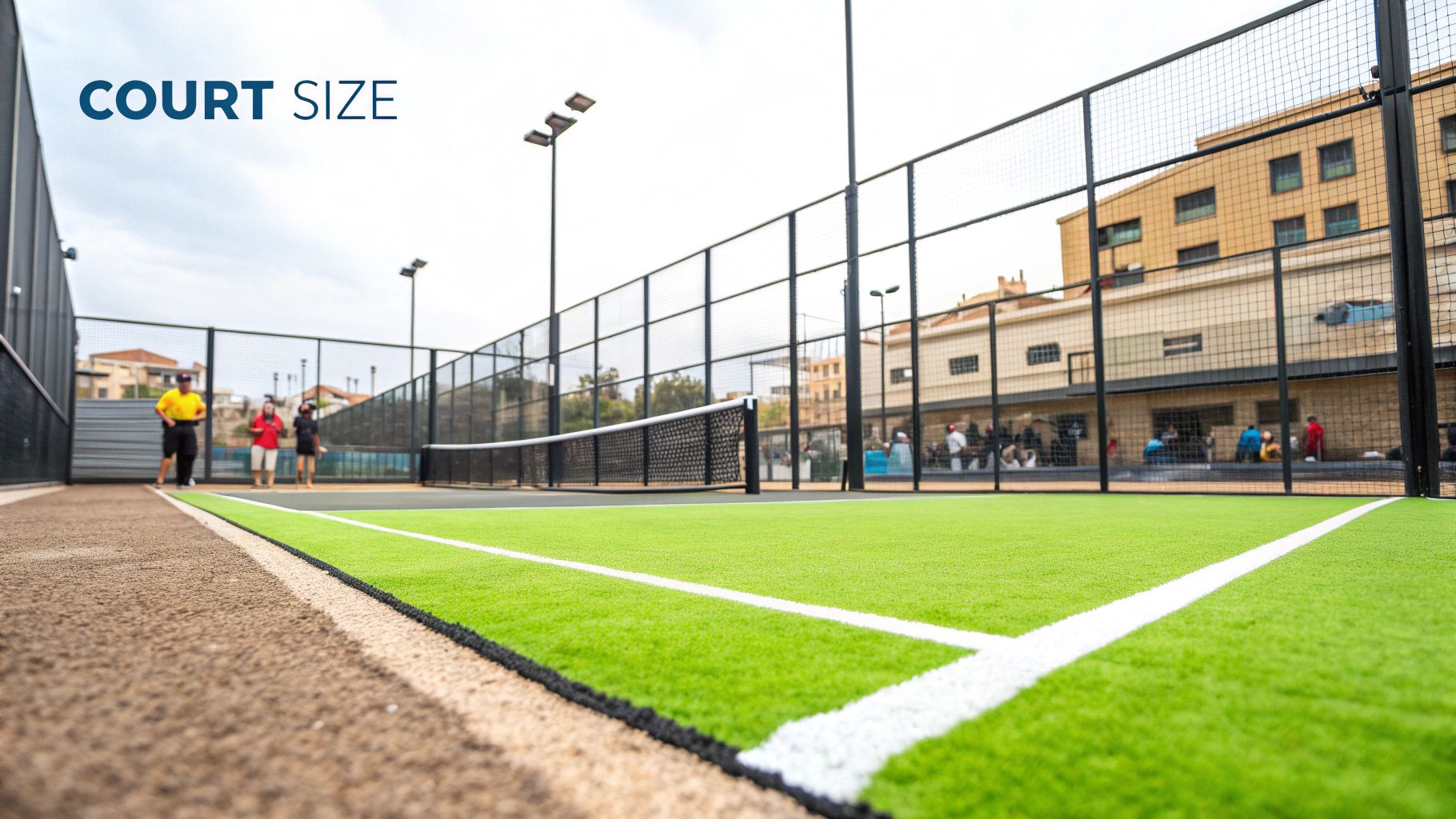
This is where the real differences between padel and tennis come alive. Sure, they share a scoring system, but the way a point is played out reveals two completely different sports. How the gameplay and rules are structured is central to the padel vs tennis debate, shaping everything from how quickly you can learn to the deepest strategies.
It all starts with the serve. Honestly, this one single shot is probably the biggest game-changer for anyone new to either sport. The tennis serve is a weapon. It's an aggressive, overhead motion that can take years to master and can completely dominate a match. For a beginner, it's often the biggest hurdle to just getting a game started.
Padel, on the other hand, takes the power out of the serve on purpose. The rules are simple: you bounce the ball once, then hit it underhand, at or below your waist. This simple change completely levels the playing field. The serve is just a way to get the point going, not end it. This shifts all the focus to the rally, which is a huge reason padel is so easy to pick up and have fun with from day one.
Rally Construction and Strategic Focus
The flow of a rally in each sport couldn't be more different. Tennis is played on a big, open court, making it a game of pure power and athletic ability. Players are trying to hit huge groundstrokes, push their opponents around, and smash a clean winner. The rallies can be short and intense, often won by whoever hits harder and runs faster.
Padel gameplay is a whole different beast. Because the court is enclosed by glass walls, constructing a point feels more like solving a puzzle. A shot that would be an obvious winner in tennis might just be the opening move in a new strategic play in padel. Players quickly learn to use the back and side walls to defend themselves, reset a point, or create crazy new angles for an attack.
This brings a level of tactical patience that isn't always there in tennis. Instead of going for a knockout blow, padel teams work together to build the point, looking for a weakness and waiting for the perfect chance to move to the net. If you want a deeper dive into these unique strategies, our beginner's guide breaks down how to play padel in detail.
Padel rewards patience and intelligence over pure athletic force. The walls act as a safety net, extending rallies and encouraging players to think two or three shots ahead, making it a highly cerebral sport.
The Mental and Physical Skills Cultivated
Because the gameplay is so different, each sport builds a unique set of skills. To be successful in tennis, you need a serious mix of physical power and technical skill. Players need:
- Explosive Power: For serves and massive groundstrokes.
- Exceptional Stamina: You have to cover a lot of ground in a long match.
- Technical Mastery: Perfecting complex shots like slices, topspin, and volleys.
Padel, however, puts the focus on finesse and teamwork. The key abilities here are a bit different:
- Quick Reflexes: Especially for those fast-paced exchanges at the net.
- Strategic Positioning: Knowing where to stand on the smaller court is everything.
- Tactical Communication: You have to be constantly talking to your partner to succeed.
What this means is that a top-tier tennis player with incredible power might actually struggle at first against a seasoned padel team that truly understands the angles and how to use the walls. When it comes down to the padel vs tennis choice, it often depends on what kind of skills you want to build. Are you drawn to the individual, athletic challenge of tennis, or the strategic, team-based puzzle of padel?
Exploring the Social Scene and Global Growth
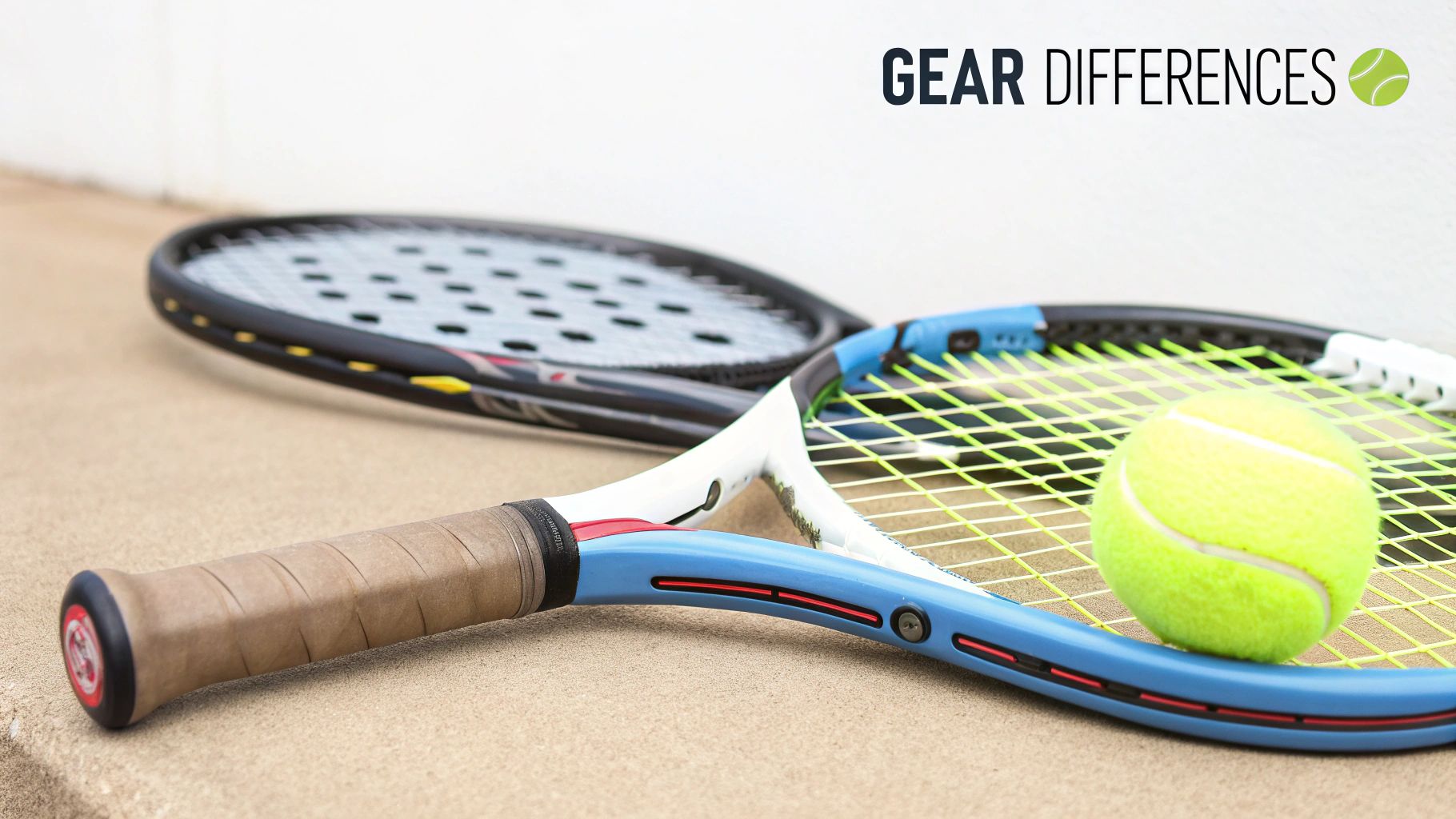
Sure, we can talk about courts, rules, and gear all day, but where these two sports really diverge is in their culture. The entire vibe—the social fabric of the game—is completely different. Tennis comes with a rich, century-old legacy that has cultivated a more traditional, established atmosphere.
Padel, on the other hand, is defined by its explosive growth and its inherently social design. The game is built for interaction. With its mandatory doubles format and a much smaller court, you’re in constant, close contact with three other people. This setup naturally sparks communication, teamwork, and a real sense of camaraderie right from the first serve.
The Community-Centric Padel Experience
Walk into any padel club, and you'll notice they're built to be social hubs. People hang around before and after matches, creating a buzzing, relaxed atmosphere. It's an incredibly inclusive scene that brings together everyone from seasoned athletes to total newcomers.
This welcoming environment is a huge reason for its global success. The learning curve is gentle, so it’s totally normal to see mixed-skill groups just having a great time together. Newbies feel welcomed, not intimidated, because the focus is on teamwork rather than individual brilliance. The social part isn't just a bonus—it's baked into the very DNA of padel.
The numbers behind this boom are staggering. Padel is widely called the fastest-growing sport in the world, with over 25 million people now playing across more than 110 countries. Its heartlands, Spain and Argentina, are home to 3.7 million and 2.1 million players respectively, while countries like Sweden and Italy have also caught the fever. For a deeper dive, you can explore more detailed padel statistics that paint a clear picture of this incredible global takeover.
Tennis and Its Legacy of Individual Pursuit
The social scene in tennis is strong, but it has a different flavor. It’s a sport steeped in the history of individual competition, which lends itself to a more formal, focused culture. At its core, singles is an intense athletic and mental battle—one player against another—which naturally encourages a more individualistic mindset.
Of course, doubles tennis is hugely popular, but the sport's identity has been shaped by legendary one-on-one rivalries. Tennis clubs often feel a bit more structured, with a clear line between casual play and serious competition. The social bonds are definitely there, but they tend to form around a mutual dedication to mastering what is a very technically demanding sport.
Padel’s social gravity pulls people together through accessible, team-based fun. Tennis, conversely, often builds community around a shared respect for individual skill, discipline, and the sport’s prestigious history.
This difference is key when you're weighing padel vs tennis. Are you looking for a built-in social network from day one, or do you prefer a sport where you can zero in on personal achievement and athletic growth?
A Look at Global Reach and Demographics
Padel's rapid expansion has created a uniquely diverse and modern player base. One of the most telling signs of its inclusive nature is its appeal to women, who now make up roughly 37.55% of all players. That’s a significantly higher proportion than you’ll find in many other traditional sports.
Tennis, of course, has a massive, established global footprint with a mature infrastructure of courts, clubs, and professional tours that padel is still developing. But padel’s growth is fresh and dynamic, and it's making huge inroads across Europe, the Middle East, and North America. This new energy, combined with its balanced demographic appeal, is positioning it as a true modern sporting phenomenon, offering a community experience that stands apart from the storied legacy of tennis.
Fitness Demands and Learning Accessibility
So, how much of a workout are you signing up for? This is a huge factor when picking between padel and tennis. Both will get your heart pumping, but they demand very different things from your body and have wildly different learning curves. The padel vs tennis question often boils down to this: are you looking for a punishing athletic challenge or a more strategic game you can pick up quickly?
Tennis is, without a doubt, a beast of a workout. It’s a high-impact sport that requires some serious physical conditioning. The larger court means you're in a constant state of explosive movement—sprinting from baseline to net, lunging for wide shots, and launching yourself into overheads. It’s a fantastic cardiovascular burn, no question.
To hang in a competitive tennis match, you need real physical prowess. We're talking about the stamina for long three or even five-set battles, a rock-solid core and powerful legs for groundstrokes, and a technically demanding overhead serve. It’s the perfect sport for anyone looking to truly push their physical limits.
The Gentle Learning Curve of Padel
Padel, on the other hand, is much more inviting for beginners, both physically and technically. The court is smaller, so you’re not covering nearly as much ground. Forget the long, lung-busting sprints you see in tennis; padel is all about quick reflexes, agility, and being in the right place at the right time.
This lower-impact style makes padel incredibly accessible. It’s much kinder on your joints—especially knees and ankles—which is a massive plus for older players, anyone coming back from an injury, or people who are totally new to racket sports.
Padel’s genius is how quickly you can start having fun. The underhand serve, slower ball, and glass walls mean a total newcomer can be hitting rallies and enjoying the game in their very first hour. That’s a much taller order in tennis.
The learning curve is way less steep. Here’s why:
- Underhand Serve: Padel gets rid of the complex, powerful overhead serve. This alone makes it incredibly easy for beginners to just start playing points right away.
- Slower Ball Speed: The ball has less pressure, which slows the game down. This gives you more time to think, react, and get into position for your next shot.
- Walls Are Your Friend: The walls act like a safety net. They keep the ball in play much longer, forgiving shots that would be long or wide in tennis. This leads to longer rallies, which is how you build confidence and have more fun.
Comparing Fitness Benefits and Physical Strain
While padel is lower-impact, don't mistake it for a walk in the park. A competitive padel match is a serious anaerobic workout. It’s full of short, sharp sprints, constant changes of direction, and holding a low squat position at the net. It's brilliant for building reflexes, agility, and tactical thinking.
Tennis provides a more classic cardio and strength-building workout. The non-stop running and powerful shots build endurance and muscular power in a way padel simply doesn't. What’s better really just depends on your personal fitness goals.
Situational Recommendation:
- Choose Tennis if: You're an athlete hunting for a high-intensity physical challenge that builds explosive power and endurance. You enjoy the process of mastering difficult skills and love the pressure of individual competition.
- Choose Padel if: You want a social, strategic, and fun sport you can enjoy right away with a low risk of injury. It's a fantastic fit for all ages and fitness levels who want a great workout without the heavy impact.
This accessibility is the secret sauce behind padel's global explosion. As padel reshapes racket sports, Europe has become its heartland, with about 60% of all players. The UK is a perfect example: player numbers have shot up from just 15,000 in 2019 to an expected 400,000 by the end of 2024. That's a staggering increase that shows just how wide its appeal is. You can learn more about padel's global growth and what it means for the sport's future. This boom, especially when compared to the more steady numbers in tennis, really highlights how padel's easy entry point is bringing a whole new crowd to the court.
The Pro Tours and What It's Like to Watch
When you look at the professional tours in the padel vs tennis debate, you're seeing two sports at completely different points in their journey. Tennis is the established giant, with the ATP (men's) and WTA (women's) tours being global household names. These circuits build up to the four legendary Grand Slams—Wimbledon, the US Open, the French Open, and the Australian Open—which are more like cultural festivals than just sporting events, packed with decades of history and staggering prize money.
Padel’s pro scene, on the other hand, is the exciting new kid on the block. It’s growing up fast. What was a loose collection of semi-pro events just a short while ago has exploded into a serious, professional circuit. Today, it’s all about major tours like the World Padel Tour (WPT) and the fast-growing Premier Padel tour. These are pulling in top-tier athletes with prize money that's getting more serious every year.
Padel's Pro Scene is Catching Fire
The speed at which professional padel has organized itself is nothing short of incredible. From its humble beginnings in the 2000s, it's now a structured global sport. The biggest tours are now offering prize pools that top €4 million, a number that just keeps climbing as more sponsors and viewers jump on board. That kind of money is a powerful magnet for a new wave of dedicated pro athletes.
The professional ranks are absolutely booming, with around 4,874 players holding a professional ranking across the globe. This isn't just a random number; it's proof of padel's growing international appeal and the solid framework that now exists to support a real career in the sport. If you want to get a feel for the tournaments and players shaping padel's future, you can find awesome coverage of the Padel World Tour and its biggest stars.
Tennis and Its Global Sporting Dominance
Tennis, by comparison, has over 2,500 ranked singles players across the ATP and WTA tours, but the financial scale is just on another planet. The Grand Slams alone offer prize money in the tens of millions of dollars, turning top players into global icons. It's a well-oiled machine that has been minting superstars for generations.
As a spectator, padel is all about long, complex rallies with dramatic wall plays and brilliant teamwork. It’s a constant, high-energy show. Tennis delivers a different kind of thrill—it’s about explosive power, unbelievable individual athleticism, and the weight of history behind every iconic rivalry.
Ultimately, watching each sport tells you everything you need to know about its soul. Padel's smaller court and relentless action make for an incredibly engaging and easy-to-follow spectacle. Tennis, with its grand stadiums and raw, athletic power, offers a more awe-inspiring, dramatic experience.
Frequently Asked Questions About Padel and Tennis
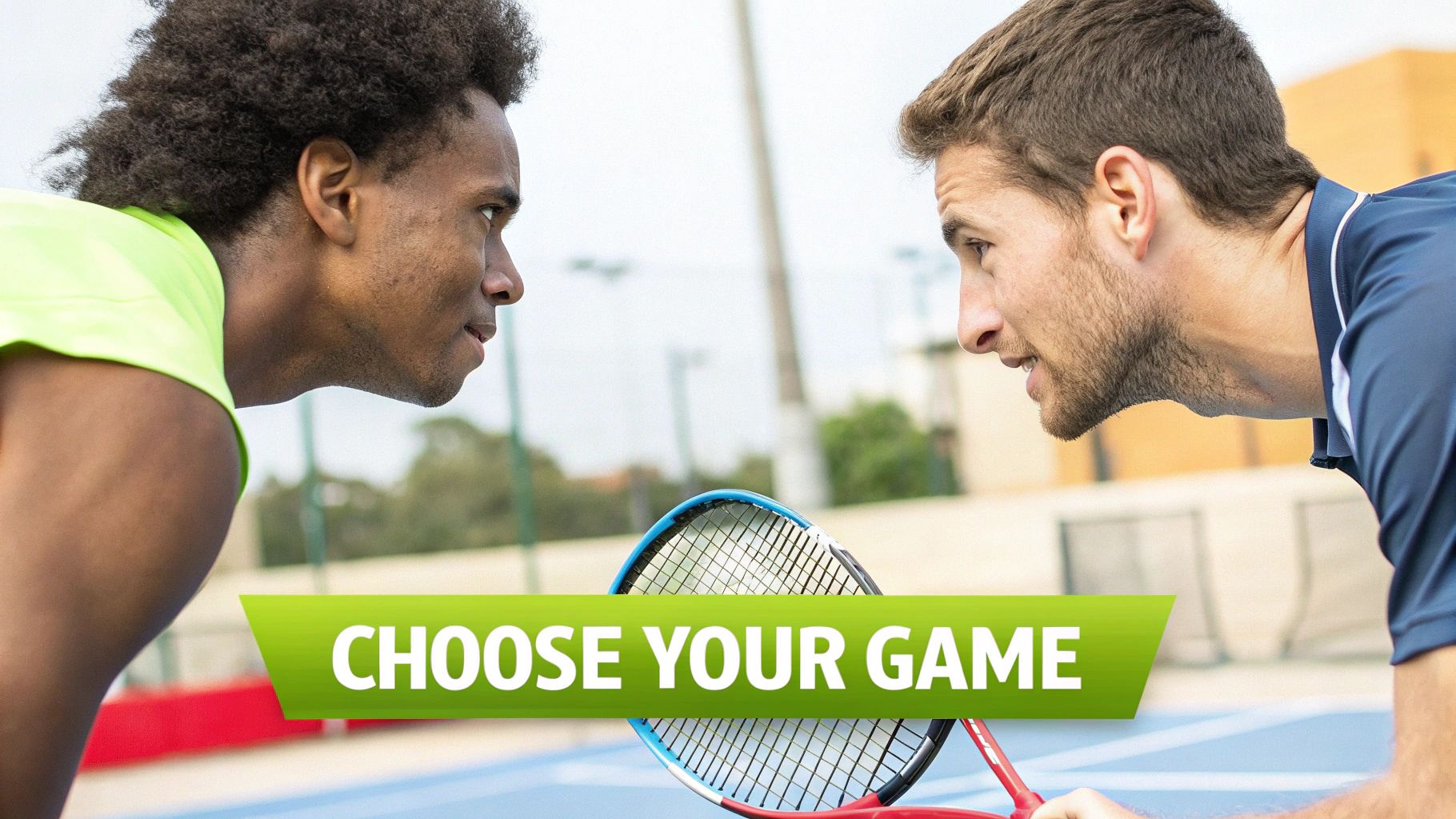
Even with a detailed breakdown, a few questions always pop up. Let's clear the air on some of the most common queries people have when choosing between padel and tennis, so you can feel confident in your decision.
Are Padel and Paddle Tennis the Same Thing?
Nope, they're two completely different sports, even though the similar names cause plenty of confusion. Padel was born in Mexico and is famous for its enclosed court with glass walls, which are a huge part of the game.
Paddle tennis, on the other hand, started in the U.S. and is played on a smaller, open court with no walls. While both sports use solid paddles instead of stringed racquets, that's where the similarities end—the rules, court dynamics, and strategy couldn't be more different.
Can My Tennis Skills Help Me Play Padel?
Absolutely! Your tennis background gives you a massive head start in padel, but you'll need to make a few key adjustments.
- Shot Technique: All your experience with volleys, smashes, and groundstrokes translates beautifully. The main change is shortening your swing to gain more control in the smaller space.
- Court Sense: Your natural instinct for where to stand and how to read your opponent is a game-changer. That court awareness is invaluable.
- Net Play: Tennis players often dominate the net in padel. Those sharp reflexes and crisp volleying skills are directly transferable and incredibly effective.
The biggest hurdle for any tennis player is learning to love the walls. Your instinct will be to hit every ball out of the air, but in padel, you have to learn to let the ball hit the back glass and rebound. It feels weird at first, but mastering the "bandeja" and using the walls is what separates beginners from seasoned players.
The core difference is adapting from a game of power to a game of patience. Tennis players must learn to resist the urge to hit every ball for a winner and instead embrace the strategic, wall-assisted rallies of padel.
Which Sport Poses a Higher Risk of Injury?
Generally speaking, tennis is the higher-impact sport of the two, carrying a greater risk for certain injuries. The bigger court demands more explosive sprinting, sharp stops, and powerful rotations, putting a lot of strain on joints in the knees, ankles, and lower back. Plus, the classic overhead serve in tennis is notoriously tough on the shoulder.
Padel is much kinder on the body because the smaller court means less intense running. The most common injuries tend to come from sudden twisting motions that can affect the knees or ankles, but the overall physical strain is significantly lower. If you're fascinated by the drama and narratives within sports, learning how to write a compelling sports article can give you great insight into capturing these athletic stories.
At Padel Rumors, we provide everything you need to dive into the world of padel, from beginner guides and pro news to the best gear reviews. Explore our resources today at https://www.padelrumors.com.


